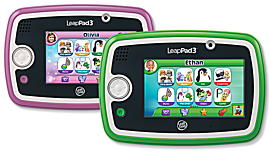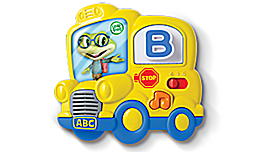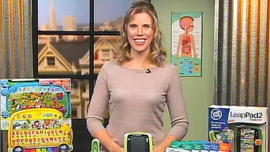Best toys for 3-year-olds
Our learning experts explain how to choose the best preschool educational toy for a 3-year-old.
Three-year-olds are full of wonder. They spend a lot of time observing, listening, watching and imitating. They begin to spend longer periods of time focused on one activity and start to approach puzzles and problems in increasingly creative and logical ways. And through it all, their oral language is bursting with new words, longer sentences and growing conversations.
As 3-year-old kids get ready for preschool, they need plenty of stimulation at home to exercise their mind and body. Many 3-year-olds enjoy listening to stories and rhymes; some even like to follow along or tell their own stories with a picture book. Their developing motor skills allow them to play with more sophisticated toys such as foam puzzles, blocks and clay, as well as draw recognizable shapes with crayons and markers. Children at this age can benefit from educational toys that challenge them intellectually.
Shopping guide: Best learning toys for 3 year olds
- Active Play Toys: Three-year-olds are becoming stronger and more agile every day. Riding toys and tricycles are perfect for growing muscles as well as building gross motor skills. Children this age can build fine motor skills as well by using crayons, molding fun shapes with clay or putting together basic puzzles.
- Pretend play toys: Toy phones, microphones, tea sets or even walkie-talkies encourage your child to use words and language in fun and meaningful ways and help nurture your child’s expressive vocabulary—the words he uses to communicate his own thoughts and ideas. To foster your child’s receptive vocabulary—the words that help him understand the thoughts and ideas of others—offer toys with built-in opportunities to teach new words related to one of your child’s interests. For example, as you play with a new train set, you can point out the “engine” the “tracks” and the “train station” where passengers can purchase “tickets.”
- Educational toys: Three-year-olds are learning a lot about how print works. As they learn to recognize letters, they build the understanding that the letter marks strung together on a page are words that convey a particular message or tell a story. ABC toys that prompt the child to match letter names and sounds, or toys that encourage children to write letters and words on an erasable surface can help build print awareness and letter knowledge. Learning toys that encourage children to count sets of objects and recognize numerals that represent these quantities help build key early math skills. And toys that allow children to sort items based on attributes like color, size or shape helps them classify in even more sophisticated ways later on.
- Creative play toys: Many children this age enjoy singing and performing. As they gain greater control over their voices, children can appreciate toys like microphones, keyboards and music players that they can fold into their latest performance. Preschoolers also enjoy dramatic play as they may take on the role of their favorite superheroes or pretend to have magical powers. Costumes and other props like wands or lasers that support their make-believe pursuits can provide hours of fun for young children.













